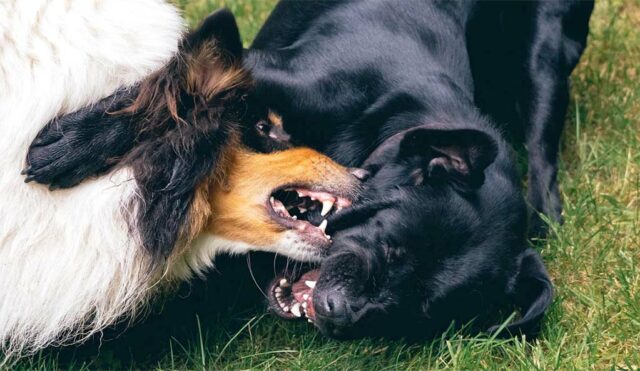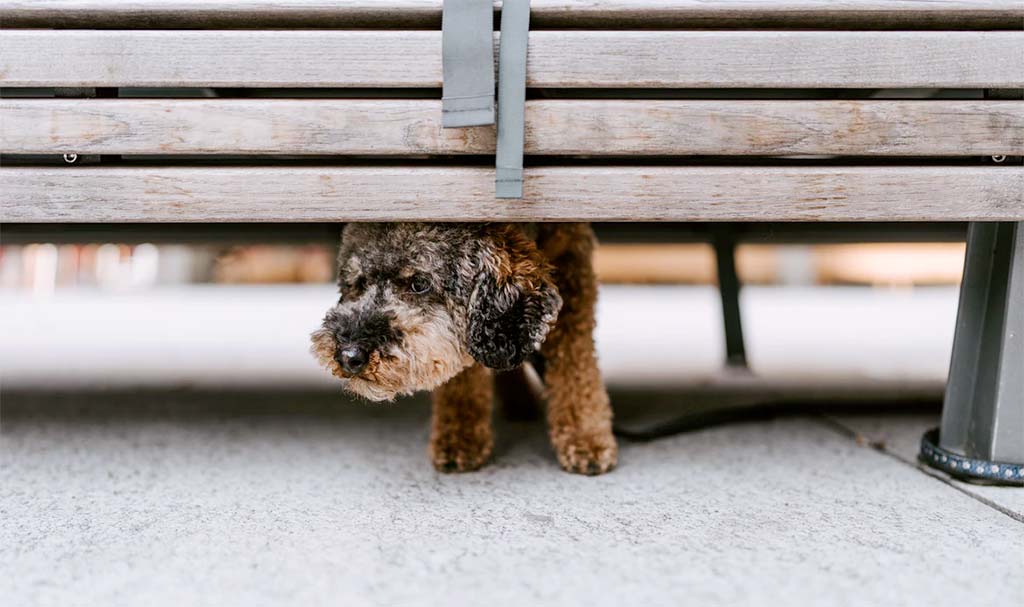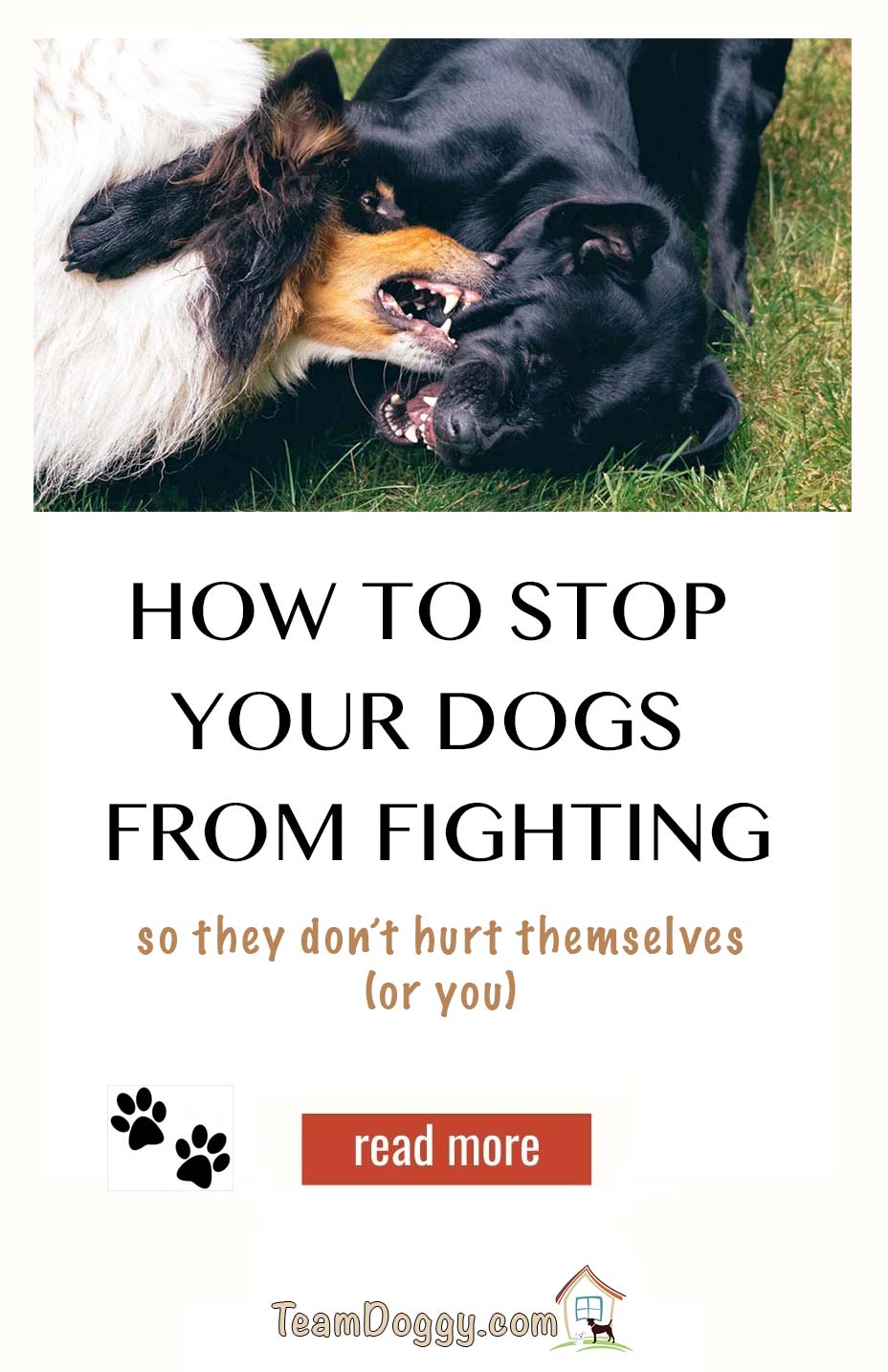
Living with multiple dogs can be a lot of fun, but it also comes with its challenges. One of the most common problems dog owners face is when their dogs start fighting. Learning how to stop dogs fighting in the same household is important knowledge to have if a situation arises. Fighting among dogs can lead to injuries for both dogs and overall tension in the household.
Table of Contents
- How to Stop Dogs from Fighting in the Same Household
- Why Do Dogs in the Same Household Fight?
- Fighting over Territory
- Guarding Their Owner
- Resource Guarding
- Becoming Over Stimulated
- Underlying Anxiety
- Fear Aggression
- Reaction to a Shock Collar
- Stop Dogs Fighting Using Counter-Conditioning and Desensitization
- What Are Warning Signs Two Dogs Are Going to Fight?
If your dog has suddenly become aggressive toward your other dog, or starts attacking other dogs in the house, don’t worry – we have some tips to help you get your pooches getting along again!
How to Stop Dogs from Fighting in the Same Household
Dogs are social creatures that enjoy being around other dogs, but sometimes they can get into fights. While some dog owners may view this as a simple squabble, dog fights can actually be quite dangerous and even lead to death. So, how can you stop your dogs from fighting?
One way to prevent fighting is to use positive reinforcement. This means rewarding your dogs for good behavior so that they associate good behavior with something positive. For example, if you see your dogs playing nicely together, give them a treat or some verbal praise. Over time, they will learn that behaving nicely leads to rewards, and this will help to discourage fighting.
Another way to stop dogs from fighting is through training. You can teach your dogs specific commands, such as “sit” or “stay,” which can help to diffuses tense situations. Training can also help you to better manage your dogs’ behavior overall and make it easier to prevent fights before they start.
If your dogs do get into a fight, it’s important to break it up carefully. Do not put yourself at risk by getting in between two fighting dogs – instead, try using a spray bottle of water or making a loud noise to startle them and break their focus. Learning how to stop dogs fighting in the same household does take some time. But if you follow the tips below you’ll have a happy healthy pack of dogs in no time.

Why Do Dogs in the Same Household Fight?
Dogs are loving companions, and they usually get along just fine with other dogs in the household. But what happens when you have a dog that feels he has to be dominant at all costs?
There are a number of reasons why dogs in the same house may fight. Territoriality, competition for resources, fear, even a desire to protect you against all perceived threats. In some cases, aggression may be the result of a lack of socialization or a history of abuse.
Here are a number of reasons your dogs might get triggered into a fight and how to stop your dogs from fighting in that instance:
Fighting over Territory
One dog may feel like the other is infringing on their territory and start to fight for dominance.
Just like wild animals domestic dogs protect their territory.This is especially apparent when there is a change in the pack hierarchy say after the pack leader dies and the other dogs in the household fight over position.
In order to prevent this from happening, it is important to establish rules and routines for both dogs so that they each know their place in the pecking order.
First, make sure that each dog has their own designated space, such as a crate or bed, where they can relax without feeling threatened by the other dog. You should also feed them separately to avoid any competition over food.
Finally, provide plenty of opportunities for positive interactions between the two dogs, such as taking them on walks together or playing dog games that encourage them to work together. By following these tips, you can help reduce the risk of your dogs getting into a fight.
Guarding Their Owner
Dogs are very protective of their owners and may fight if they feel like another dog is a threat or is getting too much attention.
One of the main reasons that dogs can sometimes become aggressive with each other is because they are seeking attention from their owner. If one dog becomes very agitated by the lack of attention they are receiving, they may lash out at another dog in an attempt to get noticed.
To prevent this from happening, it is important to give both dogs plenty of love and attention. This can be done through engaging them in active play or just spending time directly with them one-on-one.
Additionally, taking regular breaks from interacting with your dogs can also help to reduce tension between them, allowing for a calmer environment overall. By focusing on nurturing and caring for your dogs, you can help prevent fights and enjoy a harmonious relationship with both pets.
Resource Guarding
Dogs may start fighting over toys, treats, or other belongings if they feel like they’re not being fair share.
There are a few different techniques that you can use to prevent your dogs from fighting over toys or treats. The first thing that you should do is set boundaries for the dogs and make sure that they know where those boundaries are. This means that you should always try to be consistent in treating the dogs and rewarding them for good behavior.
By limiting access to toys and treats, or giving them to your dogs separately, you can help reduce the likelihood of a conflict arising.
If the dogs have already begun fighting and seem determined to continue, another technique that you can try is distraction. You can try using dog treats or engaging with them in other ways, such as playing fetch or giving some extra attention, in order to get their focus off of each other.
Becoming Over Stimulated
Dogs may become over aroused during playtime and start to fight if they get too excited.
To prevent two dogs from fighting when they get overstimulated during playtime, it is important to stay calm and take steps to redirect their excitement. One of the key things to keep in mind is that dogs are incredibly sensitive to our emotions, so adopting a positive and confident demeanor can help to diffuse a tense situation.
In addition, it is essential to break up the playtime every now and then, either by introducing a new activity or by providing some physical space between the dogs. This allows them time to reflect on what just happened and cool off before getting back into the action.
If things do start to escalate, you can try using soothing vocal tones or distracting toys and treats, which may be able to help redirect their attention back onto something more positive. With patience and persistence, you should be able to prevent your dogs from fighting during playtime, keeping everyone safe and happy!
Underlying Anxiety
If a dog is feeling anxious or stressed, they may lash out and start fights with other dogs. This could be because of loud noises or even stress due to separation anxiety.
While it may be impossible to prevent every dog fight, there are some things you can do to reduce the likelihood of your dogs getting into a scuffle due to anxiety.
The best prevention is to try to avoid putting your dogs in situations that make them anxious or stressed. Since we can’t control every circumstance this isn’t always possible. Play anxiety music for your dog. Yes it really is a thing. Playing relaxing music to calm your dog has been shown to work to reduce anxiousness and separation anxiety in dogs.
Provide your dogs with ample exercise; a tired dog is much less likely to pick a fight than one who is full of energy. If your dog lashes out after being startled by loud noises he may need counter-conditioning to correct this behavior. We discus this in detail below.
Fear Aggression
If a dog feels scared or threatened by another, they may lash out in aggression.
In some cases, one dog may feel scared or threatened by the other, which can lead to aggression. There are a few things you can do to help prevent this from happening.
First, make sure that both dogs have plenty of space to themselves. This means having separate beds, food and water bowls, and toys. Each dog should also have their own designated area within the house.
Secondly, provide each dog with ample opportunities for exercise. This will help to release any pent-up energy and reduce stress levels.
Finally, never punish one dog in front of the other. This can cause feelings of jealousy and resentment, which can lead to conflict. This can also be a trigger for a dominant dog who thinks it’s his job to reinforce your discipline of the other dog.
Reaction to a Shock Collar
If a dog is zapped by a shock collar he may transfer aggression toward another dog or animal in the household.
An immediate attack of another dog after getting a zap or buzz from a shock collar needs corrective training to prevent or desensitize that dog from that behavior. Look to the next section below for detailed methods of counter-conditioning and desensitization (CC&D) training.
This list of triggers for household dog fighting is not exhaustive, but gives a few examples of common reasons why dogs may start fighting. It’s important to try and figure out what the trigger is for your dogs’ fights so that you can better address the issue.
Whatever the cause, it is important to address dog-on-dog aggression as soon as it occurs. Otherwise, the situation is likely to escalate, leading to injuries for both animals involved. With patience and consistency, however, many dogs can learn to live harmoniously with their canine companions.
Stop Dogs Fighting in the Same Household Using Counter-Conditioning and Desensitization (CC&D)
If everything you’ve attempted to stop your dogs from fighting fails it’s time for professional dog training tips. Counter-conditioning and desensitization training can help your dogs overcome whatever is triggering them to start a fight in the first place so it never happens again.
By using CC&D techniques for household dog aggression you will change your dogs’ association with each other from negative to positive. The steps outlines below are geared toward dogs who become aggressive on sight, but they can be modified to overcome any behavior as long as you know the trigger.
The easiest way to make most dogs modify their behavior quickly is to give them a really good treat they love. Small bits of pre-cooked chicken work well because most dogs go gaga over a nice piece of chicken, or other low-cal treats you can break up into smaller pieces.
Ten Steps to Counter-Condition Your Dogs to Stop Fighting
- Determine how close your dogs can be to each other without being scared or excited. This is called the threshold distance. If one dog is more tolerant than the other with a smaller threshold distance, work at the greater distance.
- Have your assistant wait with Dog #1 at your determined threshold distance while you hold Dog #2 on a leash. Start feeding tiny pieces of a treat to your dog the moment when he sees the other dog. Your assistant will also feed treats to his dog when the second dog notices your dog.
- After a few seconds of this stop feeding treats and ask your assistant to take Dog #2 out of sight.
- Keep practicing until the sight of the other dog at the threshold distance consistently causes both dogs to look at their respective handlers expecting a treat, rather than focusing on each other. Each dog now has a positive association with the other at the threshold distance.
- Next, increase the stimulus by keeping Dog #2 in sight for a longer period of time. Continue to give treats when in view. Pause a few times to let them look at each other, then immediately dish out the treats when they do. This helps desensitize them to each other.
- If the length of time appears to make no difference to either dog and you’re getting the expectant “where’s my treat” look, no matter how long Dog #2 stays in view, you are making great progress. It’s time to increase the stimulus again by adding movement. Maintain your initial threshold distance and have your partner walk dog #2 back and forth. Do this slowly, then a little quicker. If that goes okay practice sit, down, and roll over commands.
- The next step is to start decreasing distance. Move Dog #1 a little closer to the location where Dog #2 comes into view. When you obtain consistent Conditioned Emotional Responses from both dogs at the new distance you can decrease the distance again. Continue reducing the distance until both dogs are comfortable being close to each other.
- Once they have mastered and enjoy being near each other return to your original threshold distance. This time increase intensity by having Dog #2 move around as you gradually decrease the distance between the two dogs. Look for a positive Conditioned Emotional Response from both dogs while you do so until they are happily in close proximity.
- Return to the starting distance and increase stimulus again. This time both dogs can move about naturally as you decrease the distance between them. Give them treats at each new distance before moving closer. When they can be near each other and still be more interested in you and the treats while moving around than each other your training session is almost done.
- Your final step is to find ways to engage your dogs in simultaneous, enjoyable activities together. This could be car rides, walks, swimming, hiking etc… at first keep them far enough apart to avoid any tension. While hiking or swimming keep someone between the dogs at first and gauge their emotions. If all goes well your dogs are well on their way to making friends.
If at any time during the process either dog seems anxious continue with the treats until their focus is on you and the positive reward of the treat rather than the other dog. Go as slowly as you need through this process. It may take multiple training sessions to see the results you are hoping for – be patient.
What Are Warning Signs Two Dogs Are Going to Fight?
Knowing your dog’s body language can give you an indication a fight is about to break out. Here are a few things to watch out for:
- Ears raised in an upright position
- Growling or baring teeth
- Raised hackles
- A stare down between the dogs
- Stiffened body
- Mounting
- Submissive behavior in one of the dogs
When it comes to dogs, it can sometimes be difficult to predict whether or not they are going to get into a confrontation with one another. There are, however, some common warning signs that indicate two dogs may become aggressive and possibly fight.
One such warning sign is raised hackles, or the hair along the dog’s back and shoulders. This can be an indication of anxiety or fear in the dog, which can lead to aggression as a way to protect itself from perceived threats in its environment.
Other signs include bared teeth, growling, and direct eye contact between two dogs. If you see any of these behaviors in your own pets or in other dogs around you, it’s best to take action swiftly before a fight occurs.
By training both yourself and your dogs to recognize these warning signals ahead of time, you can help avoid potential altercations and ensure that everyone stays safe and happy.
Training your dogs to stop fighting and learning how to stop dogs fighting in the same household takes time. But the rewards are an amazing healthy relationship between your dogs and any other pets in your home.









